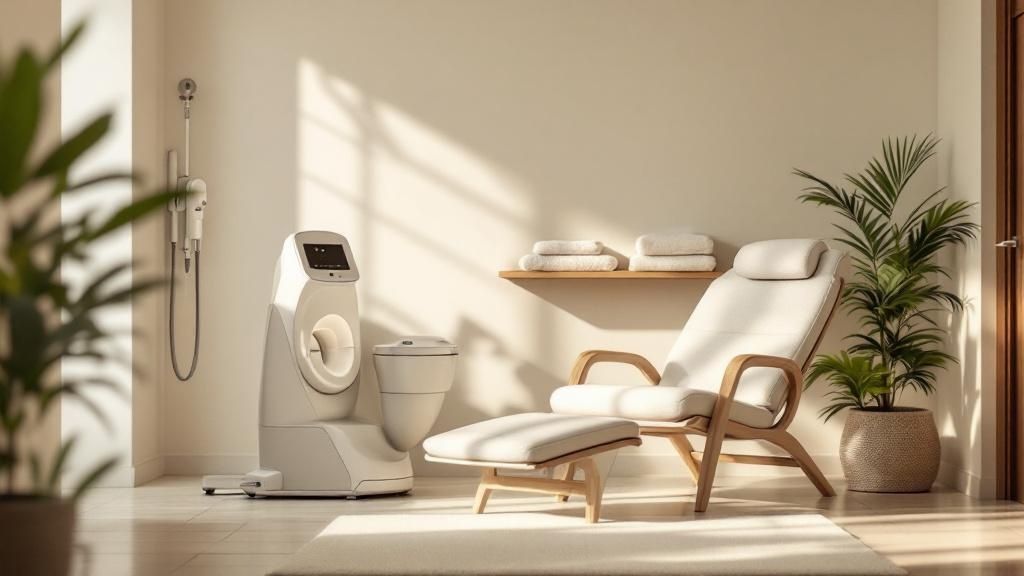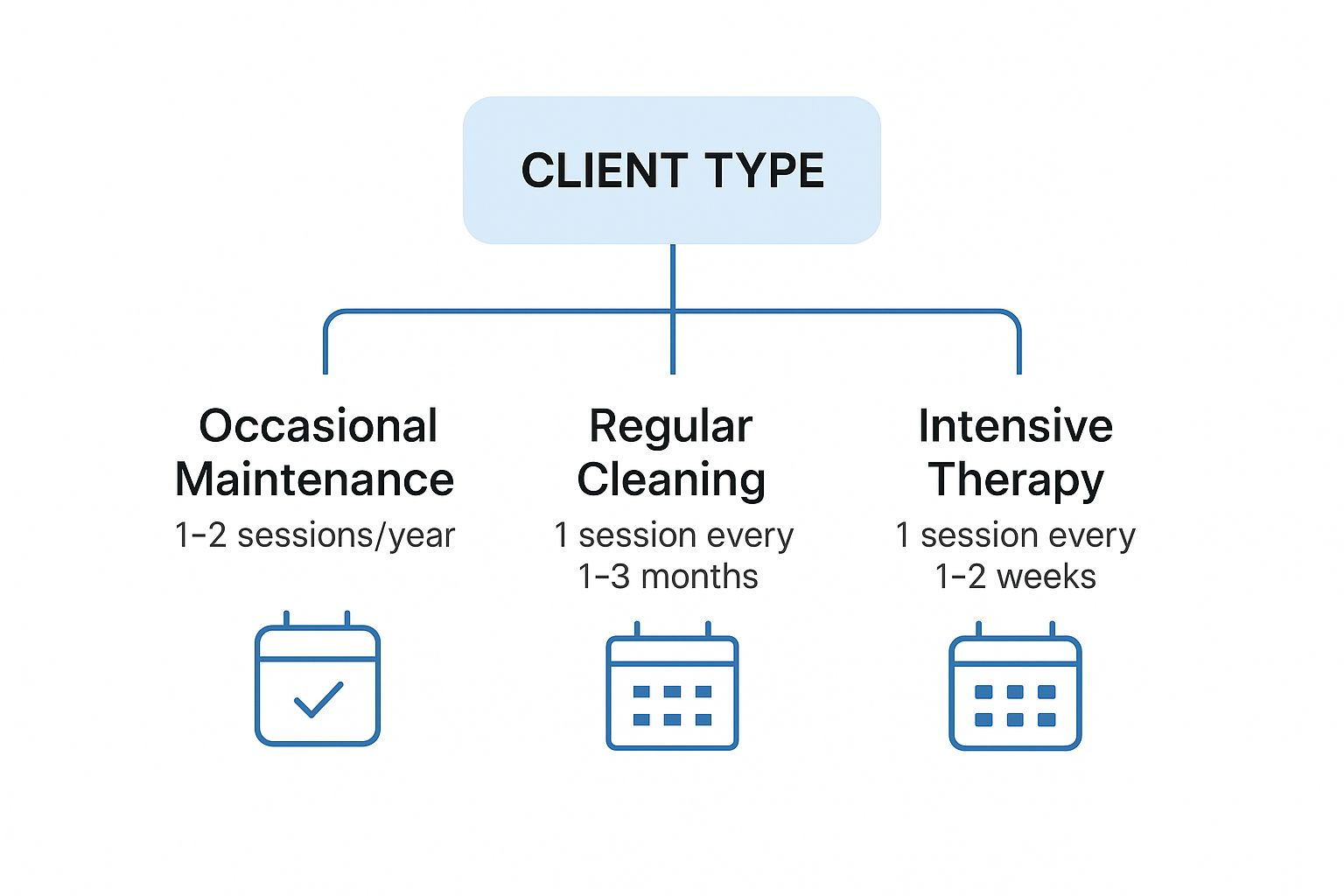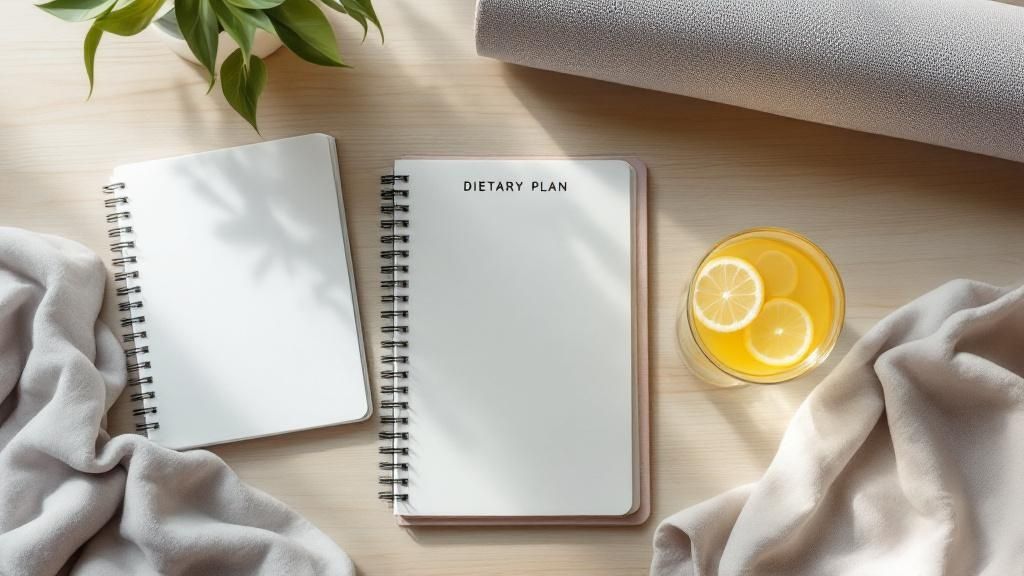One of the most common questions I hear is, "How often should I get a colonic?" The truth is, there’s no magic number. Think of it less like a rigid prescription and more like a personal wellness plan that adapts to you. For some, an initial series of sessions might be the best way to …
One of the most common questions I hear is, "How often should I get a colonic?" The truth is, there’s no magic number. Think of it less like a rigid prescription and more like a personal wellness plan that adapts to you.
For some, an initial series of sessions might be the best way to address a specific, short-term goal. For others, a single session every 3-6 months is perfect for long-term maintenance. The right answer for you depends entirely on your health goals, your body's current state, and the professional guidance of your therapist.
Finding Your Ideal Colonic Schedule

Figuring out your ideal colonic frequency is a lot like creating a fitness routine. One person might thrive on high-intensity workouts multiple times a week, while someone else gets better results from gentle yoga just once a week. Your colonic schedule needs that same level of personalization to match your body’s unique needs.
This isn't a case where "more is better." Instead, the goal is to find the right balance—a rhythm that supports your body without overdoing it. Working closely with a qualified colon hydrotherapist is the absolute best way to create a schedule that truly helps you meet your health objectives.
Factors That Shape Your Schedule
Several key elements will influence how often you should schedule your sessions. Getting familiar with these will help you have a more meaningful conversation with your practitioner and set clear, achievable expectations.
Here’s what we typically consider:
- Your Primary Health Goals: Are you trying to relieve chronic constipation? Preparing for a medical procedure like a colonoscopy? Or are you focused on maintaining your overall digestive wellness? Each goal points to a different scheduling strategy.
- Your Current Digestive Condition: Someone dealing with constant bloating and a sluggish system will naturally have different needs than a person who already has regular, healthy bowel movements.
- Diet and Lifestyle: Your daily habits play a huge role. A diet heavy in processed foods might call for a different starting point than a diet built around fiber-rich, whole foods.
- Practitioner Recommendations: An experienced therapist can assess your individual situation, listen to your body’s response during a session, and provide professional guidance tailored just for you.
To give you a better idea of what a starting point might look like, here’s a quick summary of common recommendations based on different wellness goals.
Initial Colonic Frequency Guidelines Based on Goals
| Primary Goal | Common Starting Frequency | Important Considerations |
|---|---|---|
| General Wellness & Maintenance | 1 session every 3-6 months or seasonally. | Great for those who feel generally healthy and want to maintain digestive balance. |
| Addressing Chronic Constipation | A series of 3-6 sessions, spaced 1-2 weeks apart. | This allows for progressive cleansing and helps re-educate the colon over time. |
| Preparing for a Cleanse/Detox | 1-2 sessions before the cleanse, and 1 session after. | Helps prepare the primary elimination channel and clear out toxins released during the detox. |
| Pre-Colonoscopy Prep | 2 sessions scheduled 2-3 days before the procedure. | This is a gentle, effective alternative to harsh oral laxatives for some individuals. |
| Improving Sluggish Digestion | A series of 3 sessions over 3-4 weeks. | Can help kickstart better function and clear accumulated waste. |
Remember, this table is just a guide to help you start the conversation. Your actual plan will be fine-tuned based on how your body responds to the initial sessions.
Your body provides constant feedback. The goal of a well-designed colonic schedule is to support its natural processes, not override them. Listening to your body and adjusting the plan with your therapist is fundamental to a positive outcome.
Proper preparation is also a huge part of getting the most out of every single session. To make sure you arrive ready for a smooth and effective treatment, I highly recommend learning more about what to do before a colonic hydrotherapy appointment.
What a Colonic Is and Why People Get Them
Before we can talk about how often you should get a colonic, it’s important to have a clear picture of what the process actually is. In a nutshell, colon hydrotherapy is a gentle way to cleanse the large intestine.
Think of it as a thorough internal shower for your colon. It uses warm, purified water to gently flush out accumulated waste, toxins, and trapped gas that can make you feel sluggish and uncomfortable.
A colonic is much more comprehensive than a standard enema, which only reaches the very end of the colon. The session, which usually lasts 45 to 60 minutes, uses a gentle, continuous flow of water to hydrate and cleanse the entire length of your large intestine. The result? Many people report feeling lighter and less bloated right away. For a deeper dive into the step-by-step process, you can explore our guide on how is a colonic performed.
Common Motivations for Colon Hydrotherapy
People come to us for colonics for all sorts of reasons, but it almost always boils down to a desire to feel better—to improve their digestive health and boost their overall sense of wellbeing. Everyone's story is personal, but most motivations fall into a few common categories.
Here are some of the most frequent reasons people schedule a session:
- Relief from Digestive Discomfort: This is by far the most common driver. If you're struggling with chronic constipation, frustrating bloating, or persistent gas, a colonic can help clear out impacted waste and get things moving again.
- Support for Detoxification Programs: When you're doing a cleanse or starting a new diet, your body starts releasing stored toxins. A colonic helps ensure your primary exit route—the colon—is clear and efficient, preventing those toxins from being reabsorbed.
- Preparation for Medical Procedures: Many find colonics to be a much more comfortable and gentle alternative to the harsh oral laxatives required before a colonoscopy.
- Boosting Energy and Vitality: It's common to hear clients say they feel a surge of energy after a session. When your body isn't bogged down by stagnant waste, it can often absorb nutrients more effectively, leading to a natural increase in vitality.
Alongside hydrotherapy, many people also look for natural ways to support their gut, often exploring different herbs for digestive problems.
The primary goal of a colonic isn't just to remove waste, but to hydrate the system and stimulate the colon's natural muscular action, known as peristalsis. This can help re-educate the bowel, encouraging more efficient function long after the session ends.
Understanding these different motivations is the first real step in figuring out the right frequency for you. Someone looking for relief from years of constipation will need a very different plan than someone who just wants a seasonal wellness boost. This is why a one-size-fits-all approach simply doesn't work. Your personal goals are what matter most.
Key Factors That Influence Your Colonic Schedule

When people ask how often they should get a colonic, the honest answer is: it depends. There’s no magic number or rigid rulebook here. The best schedule is one that’s built around you—your body, your health goals, and your lifestyle.
Think of it like tuning a musical instrument. You don’t just tighten the strings once and call it a day; you adjust them based on the humidity, the room's temperature, and how the instrument sounds. Your colonic schedule needs that same level of personalized attention to get the best results without overdoing it. A skilled colon hydrotherapist will partner with you to read your body’s unique cues and map out a plan that truly works.
Let's dive into the main things we consider when creating that plan.
Your Current Digestive Health and History
First and foremost, we have to look at where you're starting from. The state of your gut right now is the single biggest factor in figuring out a schedule. Someone dealing with years of chronic constipation has very different needs than a person who just feels a little "off" after a long weekend.
For instance, if a client comes in with severe, long-term constipation, we might start with a series of 2-3 sessions fairly close together, maybe over a two-week period. This allows us to gently soften and clear out deeply impacted waste. For someone else who is already quite regular, a single session might be all they need for a quick reset. Research backs this up—a 2016–2018 study found that high-volume colon irrigation gave immediate relief to 100% of patients with chronic constipation, showing just how effective it can be for more acute situations.
Your Specific Wellness Goals
What are you hoping to get out of this? Your answer to that question is our roadmap. It sets the tone for everything that follows.
Are you looking for a major system overhaul or just some regular upkeep? The frequency will shift depending on the goal.
- Deep Detox or Cleanse Support: If you're in the middle of a detox program, colonics can be a game-changer. We often schedule sessions before, during, and after to help your body flush out toxins more efficiently as they're released. A classic approach is one session to prep, another mid-cleanse, and a final one to clear everything out.
- Seasonal Wellness Reset: Many of my clients find that a seasonal tune-up is the perfect rhythm for maintenance. Scheduling a colonic once per season, or 4 times a year, helps clear out buildup from dietary changes and keeps their system running like a well-oiled machine.
Your colonic schedule isn't a permanent contract. It's a living plan that we'll adjust as your health improves and your goals shift. We might start with more frequent sessions and then taper off as your body finds its own natural balance.
Your Diet and Lifestyle Habits
What you do every day has a huge effect on your digestive health. Your diet, how much you move your body, and even your stress levels all play a role in how often you might need a colonic.
A diet heavy on processed foods, sugar, and low in fiber can make the colon sluggish and in need of more regular support. On the flip side, if you're eating plenty of fiber-rich plants, whole foods, and drinking enough water, your bowels will work much better on their own, and you'll likely need fewer sessions. The health of your gut microbiome is also a massive piece of the puzzle; actively supporting gut flora with probiotics and prebiotics can make a world of difference in your digestive function and how often you feel the need for a colonic.
The best path forward is always found by working together. A certified practitioner can take all these pieces—your history, goals, and habits—and help you build a sensible plan. We'll set realistic expectations and adjust your schedule as we see you making progress, making sure every session is safe, comfortable, and beneficial.
Putting It All Together: Sample Schedules for Different Goals
Theory is great, but let's talk about what this looks like in the real world. The question of how often you should get colonics really clicks when you see it applied to specific situations. These scenarios are just examples to show you how a plan comes together—they're not a prescription.
Think of these as common starting points that a certified therapist would then fine-tune just for you. Each one is built around a different goal, from an intensive reset to simple long-term upkeep, highlighting just how adaptable colon hydrotherapy can be.
This infographic breaks down how different client needs translate into different frequencies.

It’s a handy visual guide that groups common approaches, making it easier to see where you might fit in.
The Wellness Seeker
This is someone who already feels pretty good. They aren't dealing with major issues like chronic constipation but are proactive about their health and want to support their body’s natural cleansing rhythms.
- A Good Rhythm: One session every 3-6 months, often timed with the change of seasons.
- The Thinking Behind It: A quarterly or bi-annual session is a fantastic way to hit the reset button. It gently clears out the minor buildup from everyday life without being too aggressive, supporting consistent wellness without creating dependency.
The Detox Participant
This person is diving into a structured program, like a juice cleanse, an elimination diet, or another guided detox. The main goal here is to make sure the body’s primary exit route—the colon—is wide open and working efficiently while toxins are being stirred up.
- A Good Rhythm: An initial series of three sessions over a 7-10 day period. A popular approach is one session right before starting, one in the middle, and one more at the very end.
- The Thinking Behind It: This schedule offers support at the most crucial moments. The first session clears the path, the middle one helps manage the toxic load as it’s released, and the final one ensures everything is properly flushed out to prevent reabsorption.
The Chronic Constipation Sufferer
Here we have someone struggling with persistent sluggishness, bloating, and infrequent bowel movements. The goal isn't just about finding immediate relief; it's about helping to retrain the colon's natural muscular wave, known as peristalsis.
For more severe cases, a more intensive plan is often the best path forward. A 2016 study on patients with IBS-C found that a structured regimen significantly improved bowel movement frequency, though it's important to note these clinical plans aren't typical for general wellness. You can explore the full research on these clinical findings to better understand the therapeutic side.
A Crucial Point: A personalized plan is non-negotiable. The objective is to use colonics to help restore the body's natural rhythm, not to create a long-term dependency. As diet and lifestyle improve, the frequency should naturally decrease.
- A Good Rhythm (Initial Phase): Starting with one session per week for 3-4 weeks.
- A Good Rhythm (Maintenance Phase): After that initial series, the frequency is dialed back to once a month, then eventually to a seasonal or as-needed basis as bowel function normalizes.
- The Thinking Behind It: The initial weekly sessions are designed to soften and break down old, impacted waste. This consistent hydration and gentle stimulation helps re-educate the colon, encouraging it to start working more effectively on its own again.
To give you an even clearer picture, the table below shows how different goals can lead to very different schedules.
Comparing Colonic Schedules by Health Objective
| Scenario Example | Initial Phase | Maintenance Phase | Underlying Rationale |
|---|---|---|---|
| General Wellness | A single session to establish a baseline. | 1 session every 3-6 months (seasonal). | Proactive, gentle cleansing to support the body's natural detox processes and maintain digestive balance. |
| Detox Program Support | 2-3 sessions over 7-14 days, timed with the program. | None; sessions are tied to the specific detox period. | To assist the body in eliminating toxins released during the cleanse and prevent their reabsorption. |
| Chronic Constipation | 1 session per week for 3-4 weeks. | Tapering to 1 session per month, then quarterly as function improves. | To remove impacted waste, rehydrate the colon, and help retrain the natural muscular function (peristalsis). |
| Pre-Procedure Prep | A single session 24-48 hours before a colonoscopy. | None; this is a one-time, targeted preparation. | To ensure the colon is completely clear for optimal visibility during a medical examination. |
As you can see, there’s no one-size-fits-all answer. The "right" frequency is always the one that aligns with your body, your goals, and the guidance of a qualified professional.
Understanding the Risks of Too Many Colonics

While colon hydrotherapy can be a fantastic tool for wellness, it’s all about finding the right balance. The question isn't just about how to get the most benefits—it's also about making sure you’re not overdoing it. When sessions become too frequent, you risk throwing your body's natural rhythm out of sync.
Think of your gut like a delicate garden. The right amount of water helps everything thrive, but over-watering can drown the roots and wash away essential nutrients in the soil. In the same way, excessive colonics can disrupt the body's finely tuned systems, which is why moderation and professional guidance are absolutely essential.
Potential Side Effects and Imbalances
Most people sail through their sessions with little to no issue, but it's important to know what can happen if the therapy is overused. The most common side effects are mild and pass quickly, but it pays to be aware of the more significant (though rare) risks.
Here are a few key concerns:
- Dehydration and Electrolyte Imbalance: The therapy uses a considerable amount of water. If not managed correctly, this can lead to dehydration or disrupt the body's balance of vital minerals like sodium and potassium, which are crucial for nerve and muscle function.
- Disruption of the Gut Microbiome: Your colon is home to trillions of good bacteria that are essential for digestion and a strong immune system. Overdoing it with cleansing could wash away some of this healthy flora, temporarily upsetting your gut's natural environment.
- Bowel Perforation: This is an extremely rare but very serious complication where the intestinal wall is punctured. It's almost always associated with poorly trained technicians or old, faulty equipment.
For a deeper dive, you can learn more about potential colon hydrotherapy side effects and see how a professional environment is designed to prevent them.
The Importance of Professional Standards
Following strict safety and hygiene protocols is non-negotiable in this field. It's impossible to overstate how critical proper equipment sterilization is. A tragic and completely avoidable outbreak of amebiasis in Colorado from 1978-1980 was traced back to a single clinic that failed to sanitize its equipment. This resulted in 10 patients needing surgery and, sadly, 6 deaths.
This historical event underscores why choosing a certified therapist who adheres to the highest sanitation standards is so vital. You can read more about these historical clinical findings and see how the industry has evolved.
Your safety is always the number one priority. A certified colon hydrotherapist will conduct a thorough health screening before you begin and will only use single-use, disposable equipment to completely eliminate any risk of cross-contamination.
The point isn't to scare you, but to empower you. By understanding the importance of moderation and professional care, you can make sure your colon hydrotherapy journey is both safe and wonderfully beneficial.
Common Questions About Colonic Frequency
Even with a solid plan, a few questions always pop up when you're trying to get the timing just right. Let's tackle some of the most common things people wonder about when scheduling their colonics.
Can You Get Colonics Too Often and What Are the Signs?
Yes, you can absolutely overdo it. Think of it like this: a little bit of water is essential for a houseplant, but over-watering it can cause root rot. The same principle applies here—too much of a good thing can throw your body's natural systems out of whack, potentially leading to dehydration, electrolyte imbalances, or messing with your gut's delicate microbiome.
One of the biggest red flags is dependency, where your body starts to rely on the treatments to have a bowel movement. Other signs that you might be going too often include:
- Lingering cramping or bloating long after a session ends.
- Feeling unusually tired or weak.
- Noticing your natural bowel habits have changed for the worse when you're not getting treatments.
The key is to listen to your body. Any good practitioner will keep a close eye on how you're responding and adjust your schedule to make sure the therapy is helping, not hurting.
How Long Should I Wait Between Colonic Sessions?
There’s no one-size-fits-all answer here; the ideal time between sessions really comes down to your personal goals and what your practitioner recommends.
If you're starting out with an initial cleanse or dealing with significant constipation, your therapist might suggest a series of sessions spaced closer together. That could mean coming in every 3-7 days for a few weeks. This approach is designed to gently and methodically clear out old, stubborn waste without overwhelming your system.
For ongoing wellness and maintenance, however, the gap is much wider. Most people find that a session once a month or even just once a season is plenty. As a rule of thumb, you should always wait at least 48-72 hours between any two appointments to give your body time to rehydrate and get back into its own rhythm.
The goal is always to support your body's natural functions, not replace them. The time between sessions gives your colon a chance to integrate the benefits and work on its own.
Does Diet Affect How Often I Should Get Colonics?
It makes a huge difference. What you eat is one of the biggest factors influencing how often you might need a colonic. If your diet is heavy on processed foods and low on fiber and water, your digestion is likely going to be sluggish. In that case, you might benefit from more frequent sessions at the beginning to help get things moving again.
On the other hand, if you eat a clean, high-fiber diet packed with whole foods and drink plenty of water, you’ll probably need colonics far less often. Your digestive system is already getting the support it needs, so you might just pop in for a seasonal tune-up. The ultimate aim is to use colonics as a tool to support better dietary habits, eventually getting to a place where you don't need them very often at all.
Ready to create a personalized plan that supports your unique wellness goals? The certified therapists at Healing Waters Wellness Center are here to guide you with over 15 years of professional experience. Book your consultation today and take the first step toward balanced digestive health.






